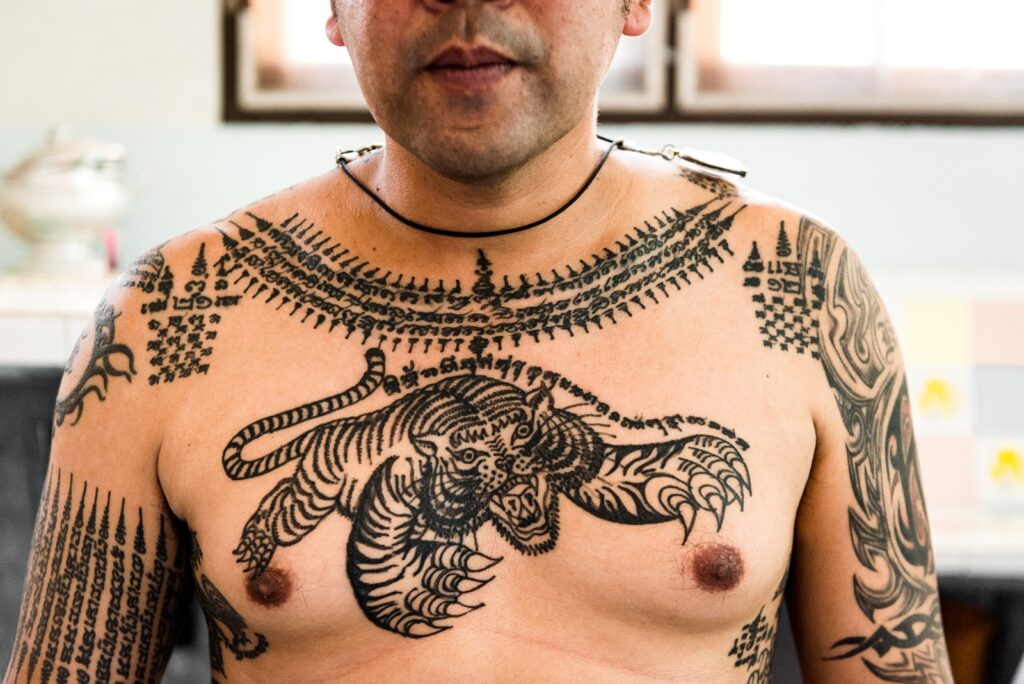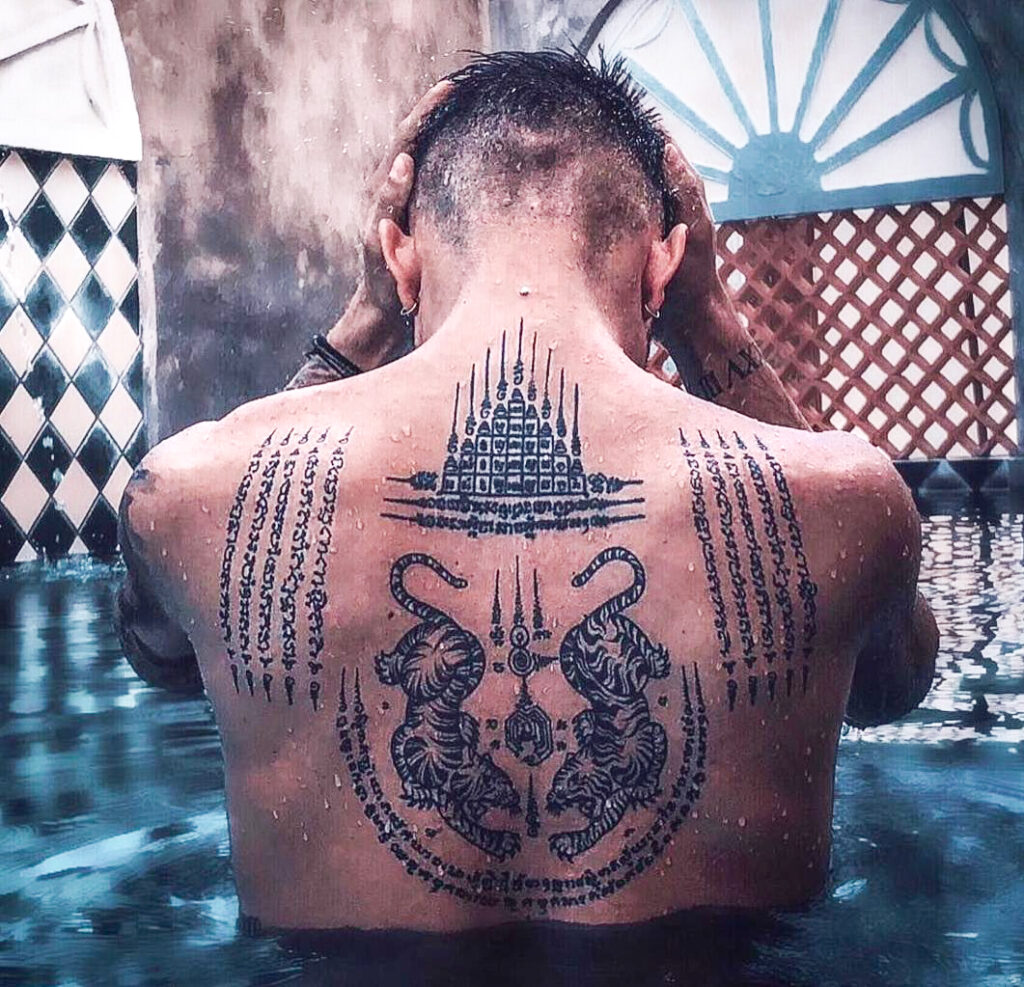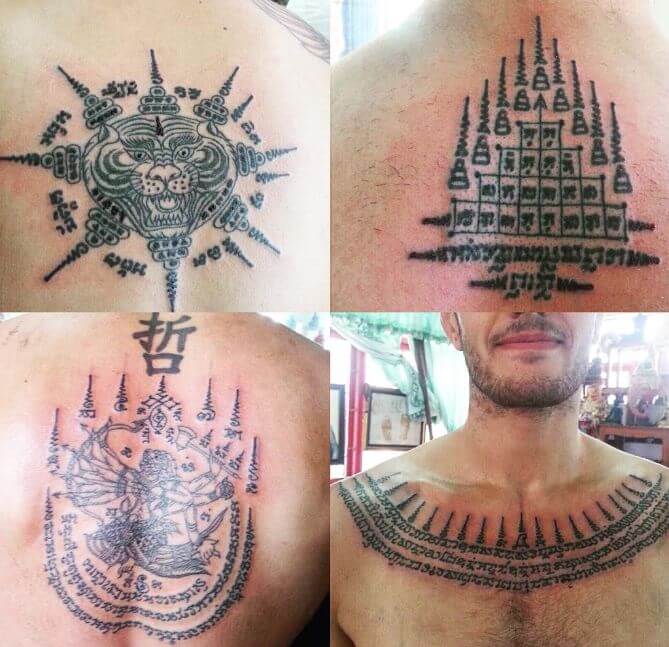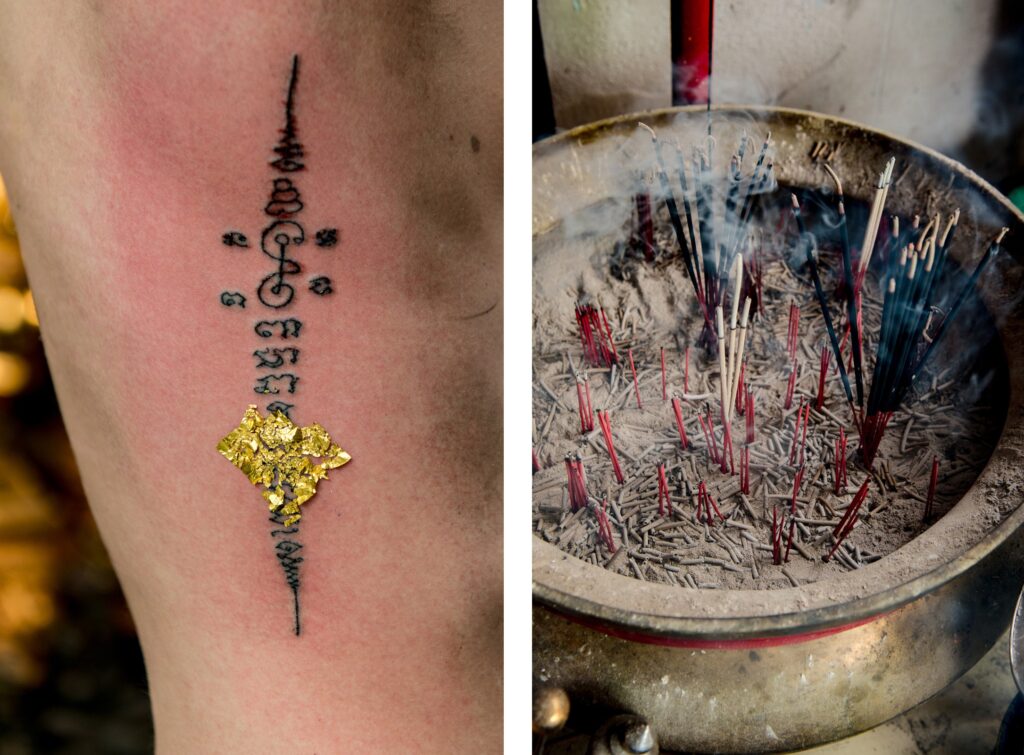Hey there! Have you ever heard of the sacred tattoos of Thailand? They’re called Sak Yant, and they have a fascinating history and tradition behind them. In this article, we’ll delve into the world of Sak Yant tattoos and explore their unique art and ritual.
Sak Yant tattoos are an integral part of Thai culture and are believed to offer protection, strength, and good fortune to those who wear them. These tattoos are unlike any other kind you might have seen before. They are created with a long metal rod or bamboo stick that has been blessed by a monk and inserted into the skin, leaving behind intricate designs that hold deep meaning.
The ritual of receiving a Sak Yant tattoo is equally important as the tattoo itself. It usually takes place in a temple or sacred location, where the person seeking the tattoo undergoes a spiritual ceremony conducted by a monk. The monk blesses the tattoo and infuses it with spiritual powers, connecting the wearer to the divine. It’s a powerful and meaningful experience that goes beyond just getting inked.
If you’re curious to learn more about Sak Yant tattoos, their symbolism, and the artists who create them, keep reading! We’ll explore the rich history and cultural significance of these sacred tattoos, and maybe even inspire you to consider getting one yourself. So grab a cup of tea, sit back, and let’s dive into the art and ritual of Sak Yant.

Ancient Origins of Sak Yant
Indigenous Shamanic Practices
Sak Yant, also known as Yantra tattoos, have ancient origins rooted in the indigenous shamanic practices of Southeast Asia. These tattoo designs were initially used by indigenous tribes as a form of spiritual protection and to enhance their connection with the spiritual realm. The tattoos were believed to bestow supernatural powers and serve as a medium for receiving divine guidance.
Influence of Buddhism
Over time, Buddhism began to influence the practice of Sak Yant. The integration of Buddhist beliefs and symbols resulted in a unique blend of indigenous shamanism and Buddhist spirituality. Buddhist monks played a crucial role in the evolution of Sak Yant, as they began incorporating prayers and sacred incantations into the tattooing ritual.
Historical Significance
Sak Yant holds great historical significance in Thailand’s cultural heritage. These tattoos were not only admired for their aesthetic appeal but were also seen as a symbol of social status and spiritual prowess. In ancient times, warriors would adorn themselves with Sak Yant tattoos, believing that the intricate designs would provide them with protection in battle and bless them with strength and courage.
Meaning and Symbolism
Protection and Blessings
One of the main purposes of Sak Yant tattoos is to offer protection and blessings to the wearer. Each tattoo design is believed to possess specific spiritual qualities that align with the individual’s needs and desires. These tattoos serve as a shield against evil spirits, black magic, and other negative energies, ensuring the wearer’s safety and well-being.
Depiction of Deities
Sak Yant tattoos often depict deities from Buddhist and Hindu mythology. These deities are revered for their divine attributes and are believed to bestow their blessings upon the wearer. For example, tattoos featuring the image of Ganesha, the elephant-headed god, are believed to grant wisdom and remove obstacles from the wearer’s path.
Representative Animals and Elements
Sak Yant tattoos also incorporate animals and elements that hold symbolic meanings. The tiger, for instance, symbolizes strength, courage, and protection, while the dragon represents power, wisdom, and transformation. Elements like water, fire, earth, and wind are also often incorporated into the designs, symbolizing the balance and harmony of nature.

The Process of Getting a Sak Yant Tattoo
Choosing a Suitable Design
Getting a Sak Yant tattoo is a deeply personal and spiritual experience. Before getting inked, it is crucial to consult with a knowledgeable tattoo master or Ajarn who can guide you in choosing a design that aligns with your intentions and spiritual aspirations. The master takes into account various factors such as birthdate, zodiac sign, and personal preferences while recommending a suitable design.
Preparing the Recipient
Sak Yant tattoos are not merely decorative; they involve a sacred ritual that requires mental and physical preparation. Before the tattooing process, recipients are required to observe certain moral and ethical principles, such as abstaining from alcohol and engaging in negative behaviors. This preparation is believed to purify the body and mind, allowing the tattoo’s spiritual powers to manifest fully.
Performing the Tattooing Ritual
The tattooing process itself is a sacred ritual that is conducted with great care and attention to detail. The tattoo master or Ajarn starts by invoking prayers and chanting incantations to invoke the spiritual energy and blessings into the design. The tattoo is then meticulously etched onto the skin using a traditional bamboo or metal rod, called a “mai sak,” which is believed to enhance the tattoo’s potency.
Sacred Tattoo Designs
Nine-Spined Dragon
The nine-spined dragon is one of the most popular Sak Yant designs, representing power, protection, and transformation. This intricate design often covers the entire back and is associated with the mythical creature Naga, symbolizing water and abundance. The nine spines represent the nine astrological directions, providing the wearer with complete spiritual protection.
Tigers and Tigerskin
Tiger Sak Yant tattoos are sought after for their association with strength, courage, and authority. The tiger, known as “Seua” in Thai, is revered as the king of the jungle and is believed to possess great mystical powers. Tigerskin designs, on the other hand, represent invulnerability and are often chosen by individuals seeking protection from physical harm.
Hanuman, the Monkey God
Hanuman, the monkey god, is a prevalent deity in Thai folklore and is revered for his loyalty, courage, and agility. Sak Yant tattoos featuring Hanuman are believed to grant the wearer strength, protection, and the ability to overcome obstacles. Hanuman’s depiction often showcases his distinctive monkey face and muscular physique, symbolizing his near invincibility.

Spiritual Beliefs and Practices
Power of Sacred Incantations
Sacred incantations, known as “Katha,” are an essential element of Sak Yant tattoos. These prayers and chants are believed to activate the spiritual powers inherent in the tattoo design. The Ajarn or tattoo master carefully selects and recites the appropriate incantations, imbuing the tattoo with blessings and mystical energy.
Connection to the Spiritual Realm
Sak Yant tattoos are believed to serve as a spiritual gateway, connecting the wearer to the divine realm. It is believed that the tattoos act as a conduit for receiving guidance, protection, and blessings from higher beings and deities. Wearers often report experiencing a heightened sense of spiritual connection and intuition after receiving a Sak Yant tattoo.
Karma and Spiritual Protection
In Thai culture, the belief in karma is deeply ingrained. Sak Yant tattoos are seen as a form of spiritual protection, ensuring that the wearer attracts positive karma and repels negative energy. It is believed that the intentions and actions of the wearer are amplified through the spiritual power of the tattoo, influencing their spiritual journey and overall well-being.
Masters and Ajarns
Role of Tattoo Masters
Tattoo masters, also known as Ajarns, hold immense respect and authority in the Sak Yant community. These individuals undergo rigorous training and apprenticeship to acquire the knowledge and skills required to perform the sacred tattooing ritual. Ajarns possess a deep understanding of the cultural and spiritual significance of each design and act as spiritual guides for those seeking Sak Yant tattoos.
Training and Apprenticeship
The process of becoming an Ajarn involves years of training and apprenticeship under a knowledgeable and experienced master. The aspiring tattoo master learns the sacred art of Sak Yant, including the significance of various designs, prayers, and incantations. This traditional method of passing down knowledge ensures the preservation of the ancient Sak Yant traditions.
Famous Ajarns in Thailand
Thailand is home to many renowned Ajarns who have earned great respect and admiration for their expertise in Sak Yant tattoos. Ajarns such as Luang Pi Nunn and Ajarn Noo Kanpai have gained international recognition for their artistry and spiritual mastery. Their tattoos are highly sought after, attracting people from all over the world who wish to experience the power and spirituality of Sak Yant.

Sak Yant in Modern Times
Popularity and Global Appeal
In recent years, Sak Yant tattoos have gained widespread popularity, not only in Thailand but also internationally. The allure of these sacred tattoos lies in their spiritual significance, unique designs, and the belief in their protective qualities. Many individuals are drawn to the art form as a means of connecting with ancient traditions and seeking spiritual guidance.
Celebrity Endorsements
The popularity of Sak Yant tattoos has been further catapulted by celebrity endorsements. Celebrities such as Angelina Jolie and David Beckham proudly display their Sak Yant tattoos, bringing attention to the art form and its cultural origins. While celebrity endorsement may increase awareness, it is essential to respect the cultural significance of Sak Yant and approach the practice with reverence.
Contemporary Adaptations
As Sak Yant tattoos gain global appeal, there has been a rise in contemporary adaptations of the traditional designs. Tattoo artists worldwide have embraced the aesthetic elements of Sak Yant and infused them into their own artistic styles. While these adaptations may cater to individual preferences, it is crucial to be mindful of the cultural significance and understanding of the original designs.
Ethical Considerations and Cultural Appropriation
Respect for Thai Tradition
When engaging with the practice of Sak Yant, it is vital to approach it with respect and appreciation for Thai tradition and culture. As outsiders, it is essential to understand the significance of Sak Yant tattoos and refrain from appropriating the art form without fully comprehending its history, spiritual beliefs, and cultural context.
Avoiding Exploitation
It is crucial to be aware of the potential exploitation of Sak Yant tattoos for commercial gain. The sacredness of the art form should not be diluted or commodified for profit. When choosing to get a Sak Yant tattoo, it is essential to seek out reputable tattoo masters or Ajarns who prioritize the preservation of the art form and treat it with dignity and reverence.
Understanding the Symbolic Meaning
Before getting a Sak Yant tattoo, take the time to understand the symbolic meaning and spiritual significance of the chosen design. Each tattoo holds a unique purpose and resonates differently with individuals. By understanding and embracing the meaning behind the tattoo, you can forge a deeper connection with the spiritual aspects of the art form.

Preserving Sak Yant Traditions
Thailand’s Role in Preservation
Thailand recognizes the cultural significance of Sak Yant and plays a vital role in its preservation. Efforts are being made to protect the art form from exploitation and ensure that it continues to be practiced authentically. Organizations and institutions in Thailand are working towards safeguarding the traditions, providing support to Ajarns, and promoting awareness of Sak Yant’s importance.
Government Recognition and Support
The Thai government acknowledges the value of Sak Yant and its contribution to the nation’s cultural heritage. Sak Yant festivals and events are organized to celebrate and promote the art form, allowing both locals and visitors to immerse themselves in the rich history and spirituality of Sak Yant. The government’s support is crucial in ensuring the continued recognition and preservation of this ancient practice.
International Efforts
Beyond Thailand’s borders, international organizations and enthusiasts are playing a significant role in preserving Sak Yant traditions. Various workshops, documentaries, and educational programs have been developed to raise awareness and appreciation for this unique art form. These initiatives aim to foster cultural exchange and mutual respect, allowing Sak Yant to flourish while maintaining its authenticity.
Conclusion
Thailand’s sacred tattoos, known as Sak Yant, are much more than mere body art. They embody a rich cultural heritage, intertwining spiritual beliefs, and profound symbolism. Sak Yant tattoos have stood the test of time, remaining deeply relevant and significant in Thai culture. Whether seeking protection, blessings, or a spiritual connection, Sak Yant has captivated people worldwide, offering a unique experience that encompasses both the artistic and the spiritual. By approaching Sak Yant with respect, understanding, and cultural sensitivity, we can help preserve and appreciate this ancient art form for generations to come.
